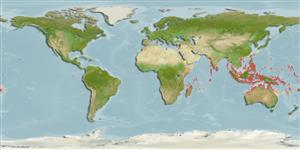Common names from other countries
>
Kurtiformes (Nurseryfishes, cardinalfishes.) >
Apogonidae (Cardinalfishes) > Apogoninae
Etymology: Sphaeramia: Greek, sphaira = ball + Greek, amia = a kind of shark (Ref. 45335).
More on author: Cuvier.
Environment: milieu / climate zone / depth range / distribution range
Ecologia
marinhas associadas(os) a recifes; intervalo de profundidade 0 - 5 m (Ref. 9710). Tropical; 31°N - 27°S, 32°E - 173°W
Indo-Pacific: East Africa to Kiribati, north to the Ryukyu Islands, south to New Caledonia; Belau to eastern Caroline and Mariana Islands in Micronesia.
Comprimento de primeira maturação / Tamanho / Peso / Idade
Maturity: Lm ?, range 6 - ? cm
Max length : 10.0 cm TL macho/indeterminado; (Ref. 4329); common length : 8.9 cm SL macho/indeterminado; (Ref. 37816)
Espinhos dorsais (total) : 8; Raios dorsais (total) : 9; Espinhos anais: 2; Raios anais : 9. Greenish grey, with dark vertical bar from origin of spiny dorsal to just in front of anus; scattered spots on body, head and 1st dorsal membrane; pelvic fins dark (Ref. 4329, 48635).
Restricted to coastal waters, forming small aggregations among mangroves, rocks, debris, or piers of shallow sheltered shorelines. Feeds at night (early evening and just before day break), primarily on planktonic crustaceans. Courtship and spawning occur fortnightly (shortly before new moons and full moons). Eggs are incubated by the male for about 8 days. Larval phase pelagic. Sexual maturity is attained at 7 cm by males and at 6 cm by females (Ref. 1602).
Courtship and spawning occur on a semi-lunar cycle, shortly before full and new moons (Ref. 37816). Distinct pairing during courtship and spawning (Ref. 205). Are mouthbrooders (Ref. 240). Males incubate up to 12,000 eggs for a period of about 8 days (Ref. 37816). After the pelagic larval phase, juveniles settle and grow at a rate of 3 to 6 mm per month (Ref. 37816).
Gon, O., 1986. Apogonidae. p. 546-561. In M.M. Smith and P.C. Heemstra (eds.) Smiths' sea fishes. Springer-Verlag, Berlin. (Ref. 4329)
Status na Lista Vermelha da UICN (Ref. 130435)
CITES (Ref. 128078)
Not Evaluated
Ameaça para os humanos
Harmless
Uso pelos humanos
Pescarias: pouco comercial
Ferramentas
Relatórios especiais
Baixar XML
Fontes da internet
Estimates based on models
Preferred temperature (Ref.
115969): 26.3 - 29.3, mean 28.6 (based on 2452 cells).
Índice de diversidade filogenética (Ref.
82804): PD
50 = 0.7500 [Uniqueness, from 0.5 = low to 2.0 = high].
Bayesian length-weight: a=0.02138 (0.01194 - 0.03827), b=3.07 (2.91 - 3.23), in cm Total Length, based on LWR estimates for this species & (Sub)family-body (Ref.
93245).
Nível Trófico (Ref.
69278): 3.6 ±0.51 se; based on food items.
Resiliência (Ref.
120179): Elevada, tempo mínimo de duplicação da população menor que 15 meses (Preliminary K or Fecundity.).
Fishing Vulnerability (Ref.
59153): Low vulnerability (10 of 100).
